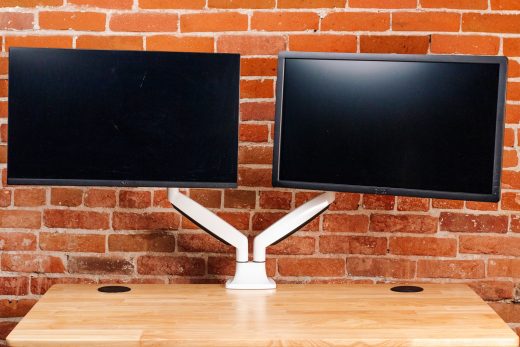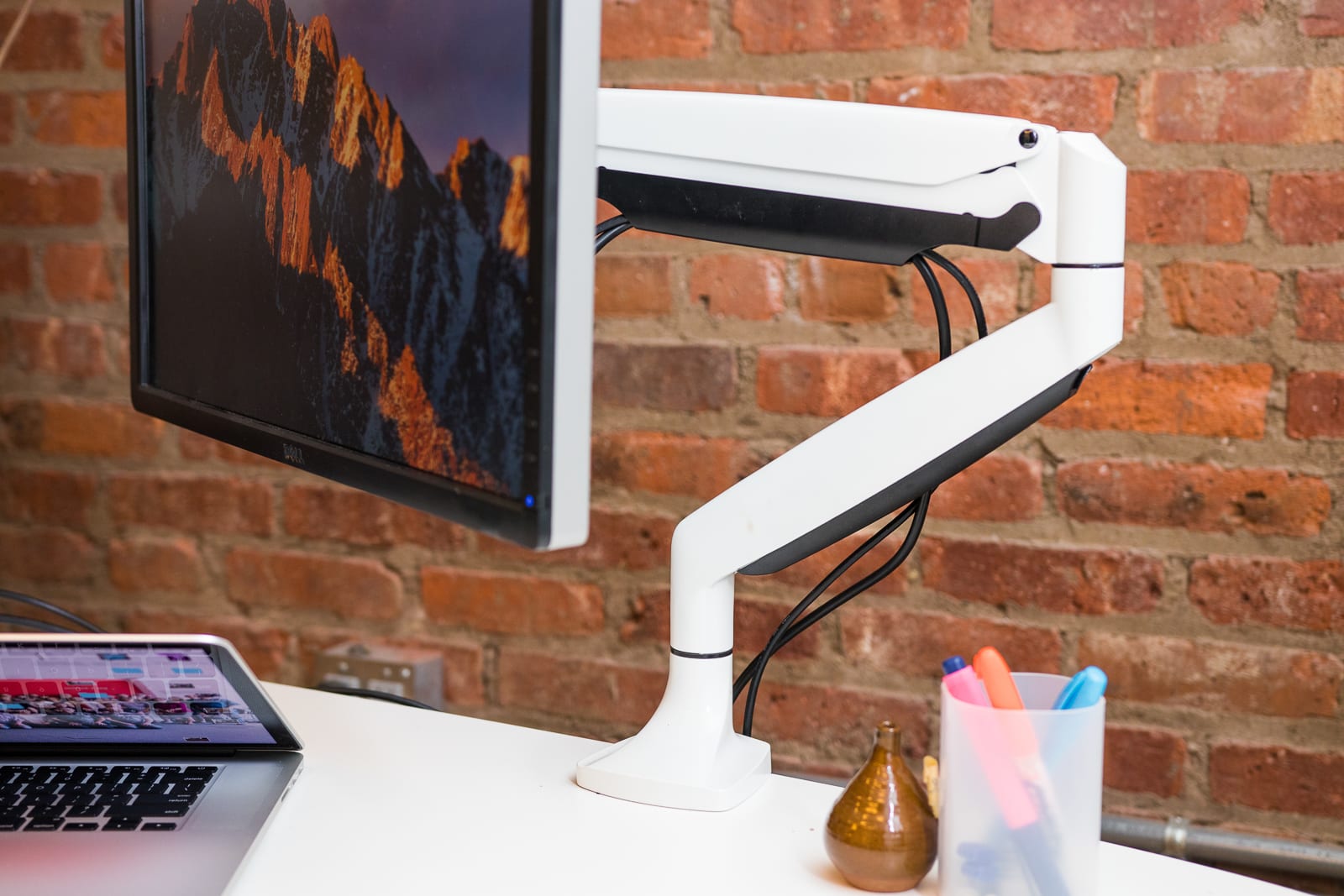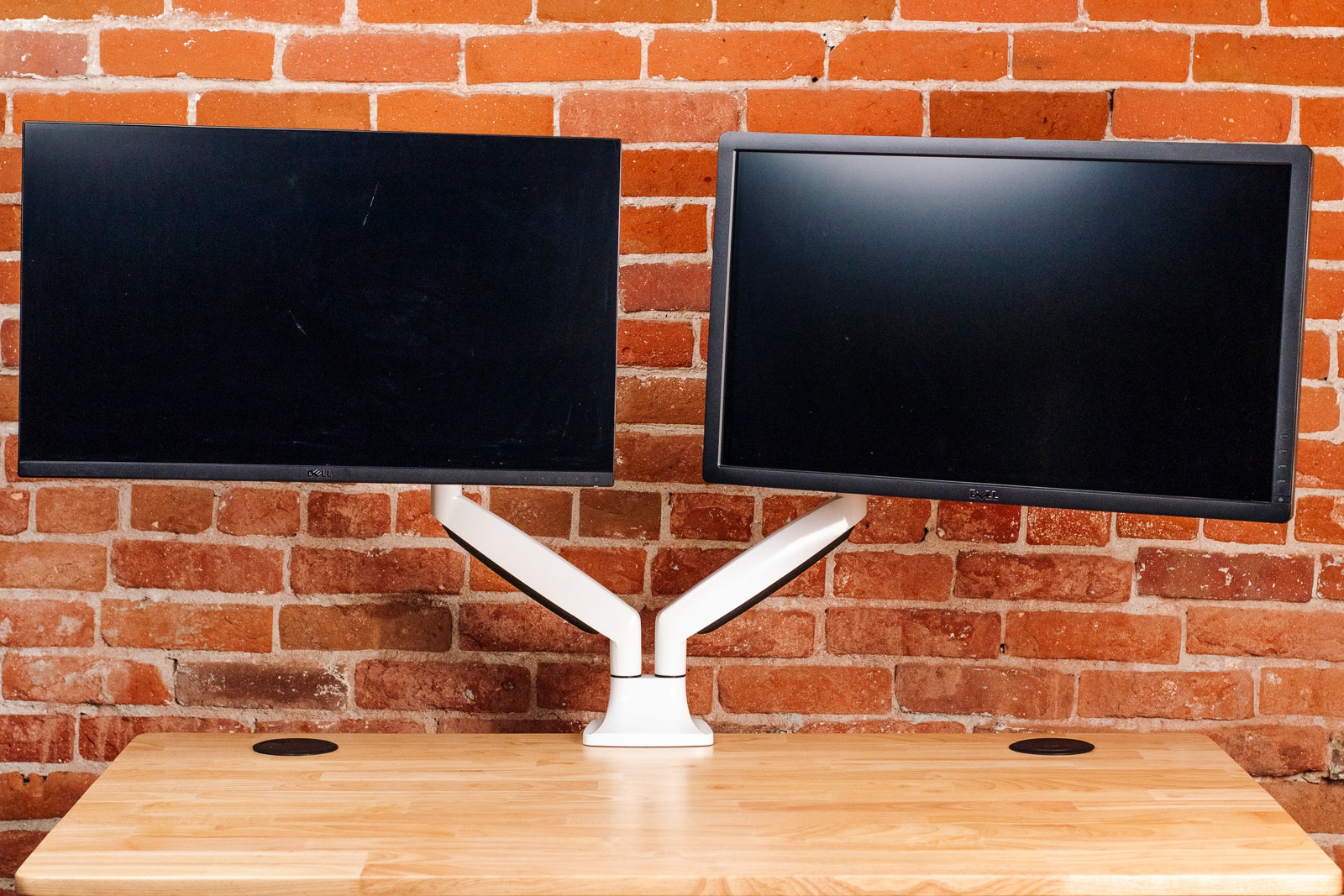The best monitor arms
By Anna Perling and Jordan McMahon
This post was done in partnership with Wirecutter. When readers choose to buy Wirecutter’s independently chosen editorial picks, Wirecutter and Engadget may earn affiliate commission. Read the full guide to monitor arms.
A great monitor arm can save space on your desk and make your workspace more comfortable and ergonomic. After researching more than 60 monitor arms and testing 13 over the past two years, we found that the Fully Jarvis Monitor Arm is the best option. It’s easy to set up, it moves smoothly into a wide range of positions and angles, and it has a solid five-year warranty.
The Fully Jarvis Monitor Arm has the same wide range of motion and sturdy build quality as its closest competitors but adds a sleeker design, three color options, and a five-year warranty without a huge price leap. Since it can support monitors up to 32 inches and about 20 pounds, it should work not just with the display you have now but with a potential upgrade in the future as well. If you’re considering our runner-up standing desk, Fully gives you a discount on the monitor arm when you buy them together.
Supported monitor size: 13 to 32 inches
Supported monitor weight: 2.2 to 19.8 pounds
Maximum height: 19.8 inches from tabletop
If the Fully Jarvis sells out and you can’t wait for it to restock, the Ergotron LX Desk Monitor Arm will work just as well. The LX has nearly identical vertical and side-to-side ranges, tilt, and pan and rotation capabilities. Ergotron monitor arms generally cost more than similar options not because of any additional features but because of the company’s impressively long, 10-year warranty. Though 10 years may seem like overkill, we think paying for such coverage is a better option than going for the savings provided by other models that offer only a one-year warranty—a monitor arm should last you many years, and the company that makes it should stand behind it.
Supported monitor size: up to 34 inches
Supported monitor weight: 7 to 25 pounds
Maximum height: 25 inches from tabletop
People over 6 feet tall need added vertical range to position a monitor at the right height, especially with a desk that lets you switch positions from sitting to standing. The Ergotron LX Desk Monitor Arm, Tall Pole has a 13¼-inch pole and can hold a monitor nearly 15 inches higher than the maximum height of the Fully Jarvis. In our tests we found that the extra height provided an ergonomically ideal range for tall people. In other respects, the Ergotron LX Tall Pole is identical to the standard Ergotron LX arm; it’s just as sturdy and easy to assemble.
Supported monitor size: up to 34 inches
Supported monitor weight: 7 to 25 pounds
Maximum height: 34 inches from tabletop
If you’re looking for a dual-monitor arm, we like the Fully Jarvis Dual Monitor Arm. As with the single-arm versions, the Jarvis dual model costs substantially less than its Ergotron counterpart—in this case, just over half as much—but comes with a shorter warranty. At five years, the Jarvis’s warranty is still plenty of coverage, and the simple setup and attractive design make the Jarvis the best dual-monitor arm for most people.
Supported monitor size: 13 to 32 inches
Supported monitor weight: 2.2 to 19.8 pounds
Maximum height: 19.8 inches from tabletop
Who should get this
If you work at a computer for long periods of time, an ergonomic setup can help prevent back and neck pain by properly positioning your screen. Especially if you alternate between sitting and standing at your desk, share a workstation with people of varying height, or just need easy, on-the-fly adjustments, you should consider a monitor arm like the ones we recommend here.
To learn about ideal workstation setups, we referred to the work of ergonomics expert Alan Hedge, director of the Human Factors and Ergonomics teaching and research programs at Cornell University.

In Ergonomic Workplace Design for Health, Wellness, and Productivity, Hedge recommends that the top of a screen be about 2 to 3 inches above eye level because human eyes see more below the horizon line than above. This arrangement can be tough for people over 6 feet tall, but a good monitor arm with a longer pole can easily fix that. To find the right height, Hedge advises, “the worker should sit back in their chair in a slight recline, at an angle of around 100°-110°, then they should hold their right arm out horizontally at shoulder level, and their middle finger should almost touch the center of the screen.” Getting your monitor position just right will let you see most of the screen without having to crane your neck. Hedge also recommends placing your keyboard just below your elbow level to ensure good posture and maintaining an elbow angle of 90 degrees or greater to prevent nerve compression.

On a laptop, this arrangement isn’t possible because its screen and keyboard are so close together. If you use a standalone monitor to raise your gaze, you’re already helping your posture, but you may need a monitor arm to get the positioning just right.
Monitor arms aren’t necessary for every person or every desk setup. If you don’t need to adjust your monitor’s height frequently, or don’t share a workspace with people of different heights, you can achieve ideal screen placement with a monitor stand, which is much cheaper and easier to set up, or even with a sturdy book or two. Our monitor picks come with adjustable stands that work for most people in most setups. But those included stands take up more space on your desk, lack the height to serve very tall people, lack the range for a proper sit/stand setup, and don’t move left and right, move forward and back, or rotate. If you need those features, you should get a monitor arm.
How we picked and tested
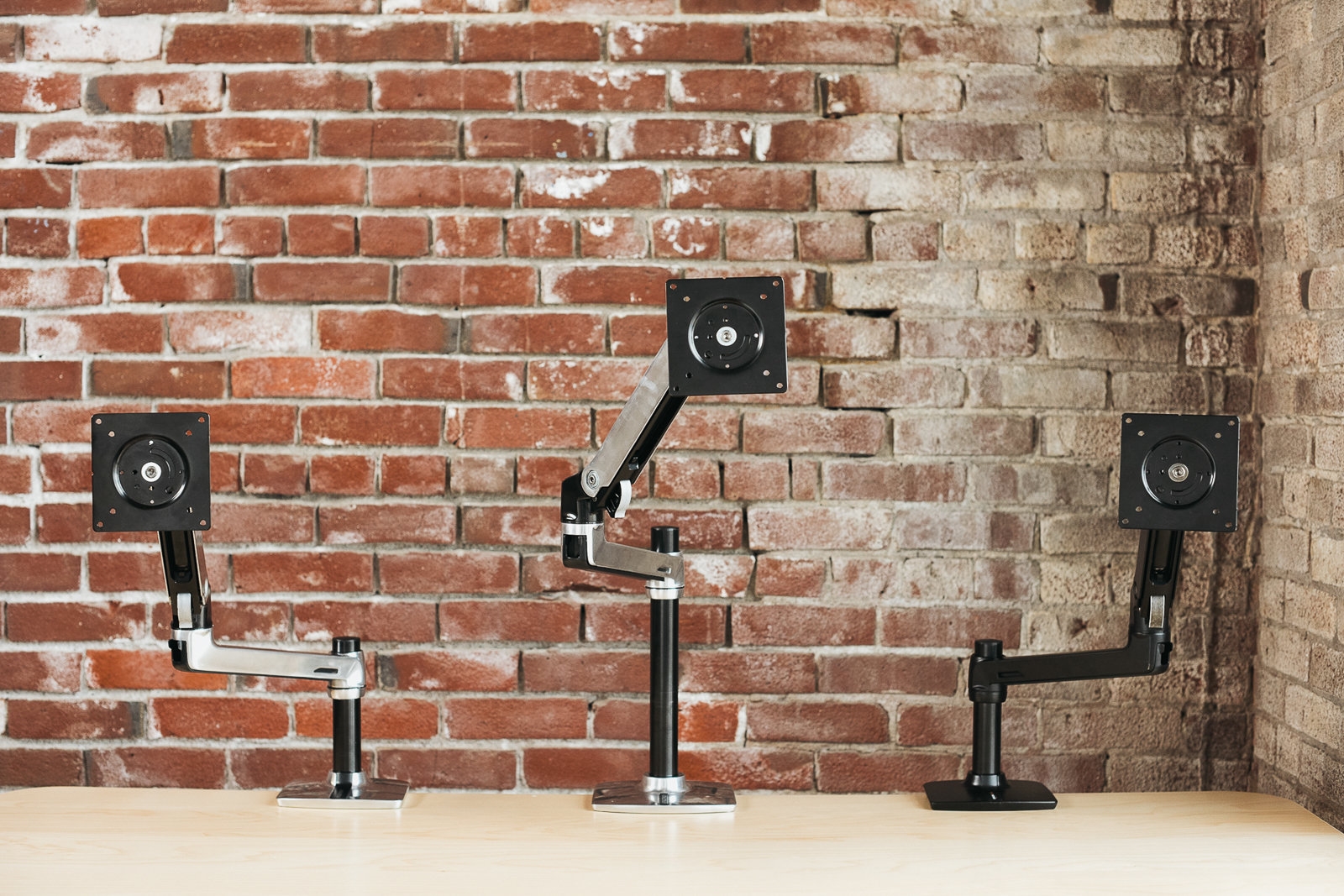
It’s not hard to get lost in the vast offerings of monitor arms, and most of them look pretty similar and offer close to identical specs. Based on our previous years of testing and covering monitor arms, here’s what takes a monitor arm from passable to great.
Support for multiple monitor sizes: Because 27-inch monitors have become so common—they don’t cost much more than smaller displays—we considered only monitor arms that could handle a screen at least that size. All the models we tested can work with smaller displays, and a few can even hold larger displays, up to 34 inches.
Wide range of motion: Everyone has a different body, a different monitor, and a different desk setup, so the wider range of motion a monitor arm has, the easier it will be for you to get the perfect placement for your display, especially if more than one person uses it. Vertical movement (up and down) is the most important range if you work at a sit/stand desk, but side to side, forward and back, and rotation and tilt are also crucial for achieving ideal ergonomics for a wide range of people, postures, and workflows.
Smoothness of motion: We preferred monitor arms that were firm enough to stay put while we worked but could reposition easily and didn’t require too much force.
Long warranty: Monitor arm technology isn’t something that will change radically and warrant a replacement every year or two. Instead, you should expect a monitor arm to last many years and adapt to changes such as a new desk or display. It’s furniture. Because of that, we looked at warranty length and customer support to see which companies would stand behind their models and the arms’ expected years of performance while holding up an expensive monitor (or two).
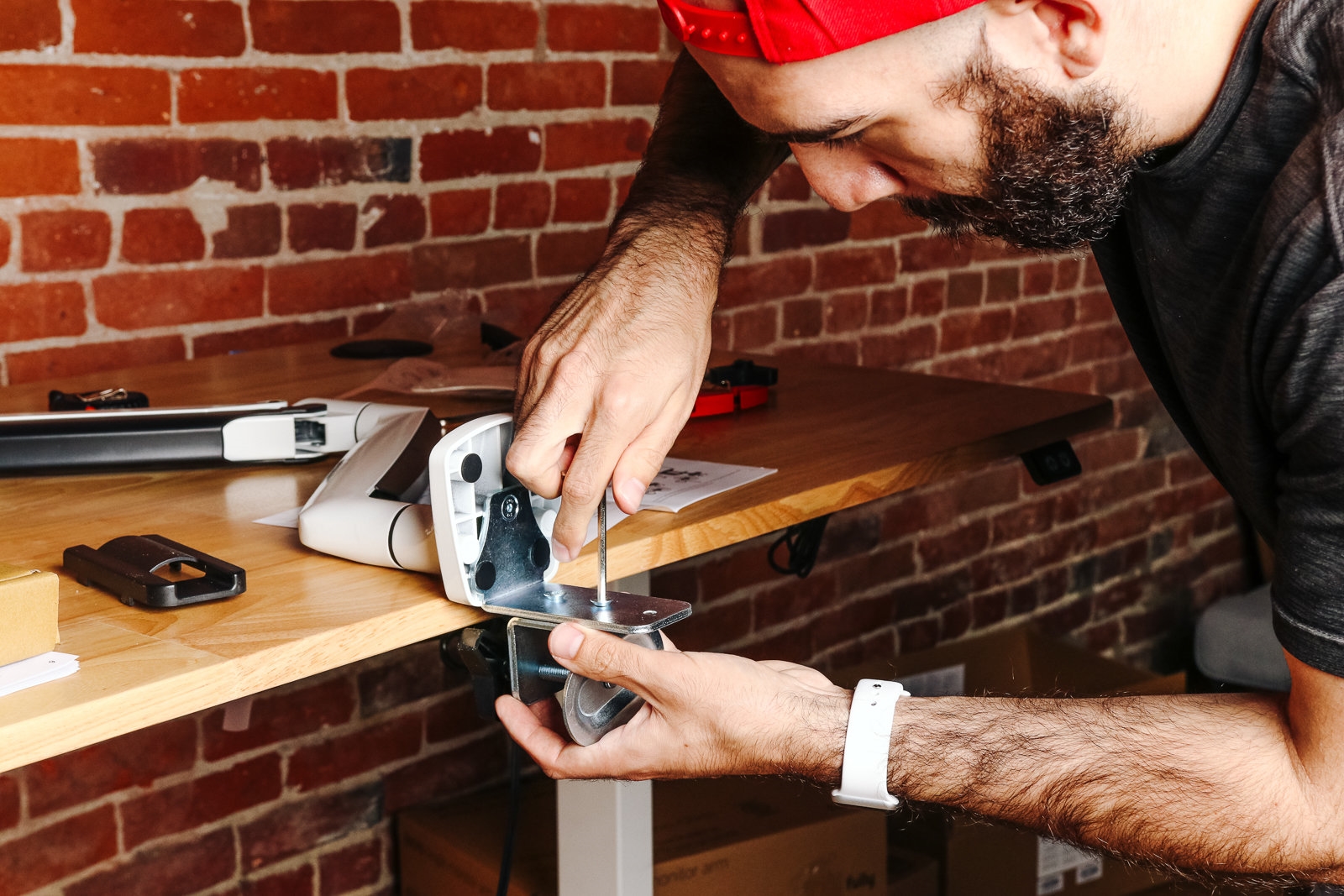
Desk mounting and VESA support: We focused on desk-mounted arms for this guide because they’re the easiest to assemble and don’t require putting holes in your wall. Monitor arms must also attach sturdily to the desk; most secure themselves with a grommet or desk clamp. A good mount should be adjustable for a range of desk or table thicknesses and widths, and it should include cable-management options, too. For the side of the arm that attaches to your monitor, we made sure the arm used the VESA standard (PDF), which just means that the screw holes and locations on screens like TVs and monitors will match the size and layout on compatible mounts—it’s common on most hardware and all of our picks.
Affordable: We learned that most monitor arms that cost less than $100 had limited vertical ranges and were typically more difficult to adjust. But we found plenty in the $100 to $200 range that met the above requirements. For that reason, we didn’t test any single-monitor arms that cost more than $200. Dual arms are, naturally, a bit more expensive, so in that category we focused on models that cost less than $300.
Easy to assemble: Monitor arms should come with clear instructions or supplementary assembly videos online. We favored monitor arms that required fewer tools to set up, too.
With the above criteria in mind, we researched 64 monitor arms and tested 11:
- AmazonBasics Single-Monitor Mounting Arm
- AmazonBasics Dual Side-by-Side Monitor Arm
- Ergotech Freedom Arm HD
- Ergotron LX Desk Monitor Arm
- Ergotron LX Desk Monitor Arm, Tall Pole
- Ergotron LX Dual Side-by-Side Arm
- Ergotron MXV Desk Monitor Arm
- Fully Jarvis Monitor Arm
- Fully Jarvis Dual Monitor Arm
- Vivo Single Monitor Desk Mount
- Vivo Dual Monitor Desk Mount
We tested by assembling each monitor arm, attaching each arm to a Dell UltraSharp U2715H (our previous pick for the best 27-inch monitor), and mounting each to a desk. For each arm we assessed the setup process, the sturdiness, and the range of movement, and we had people of varying heights use and adjust the monitor in both sitting and standing positions.
Our pick: Fully Jarvis Monitor Arm
If you want an attractive monitor arm that’s easy to set up and adjust, get the Fully Jarvis Monitor Arm. It has one of the widest ranges of motion among the arms we tested, it’s sturdy enough to support common monitor sizes and weights, and it’s also the best-looking monitor arm we tested—it comes in white, black, and silver. Fully’s five-year warranty is exceptional at this price and a worthwhile addition for something that should have a lifespan closer to a piece of good furniture than to the monitor it’s connected to.
The Jarvis works with most VESA-compatible monitors—officially it supports up to 19.8 pounds and displays as big as 32 inches. Even though other monitor arms, such as the Ergotron LX, can support 25 pounds, we don’t think most people will come up against that limit. Our test monitor, a 27-inch Dell UltraSharp U2715H, is just 10 pounds without its stand, and even a 34-inch, ultrawide display can weigh as little as 15 pounds.
The Jarvis has a 13-inch vertical range (about the same as that of the AmazonBasics arm and the Ergotron LX), which allows for a total height of 19.8 inches from the tabletop. It can extend 24 inches side to side, tilt 90 degrees, rotate 180 degrees, and pan 360 degrees.The Jarvis takes some fine-tuning with a hex key to get the tension on the arm just right, but it’s responsive and simple to adjust. It also has handy slots in the back where you can store the hex key—something other arms don’t offer—so the hex key remains convenient for making minor adjustments in the future if the setting loosens or you switch to a new display with a different weight.
Fully includes a five-year warranty, which we think is a huge benefit over the one-year warranties of other models. A great monitor arm should last a long time and keep you comfortable whether it’s attached to your current desk and monitor or your next setup years down the line. Fully—like Ergotron and Amazon—offers support via phone or email for its models. But none of the warranties cover damages to your monitor if the arm fails.
The Jarvis’s VESA mount system is different from those of other arms we looked at—instead of using screws or knobs to secure the VESA mount to a monitor, the Jarvis’s VESA mount has a tab that slides into a slot on the end of the arm, securing the monitor to the arm. This design didn’t affect the overall security of the monitor, and it kept the monitor in place as well as other mounts we tested, but it did add some confusion for us during setup.
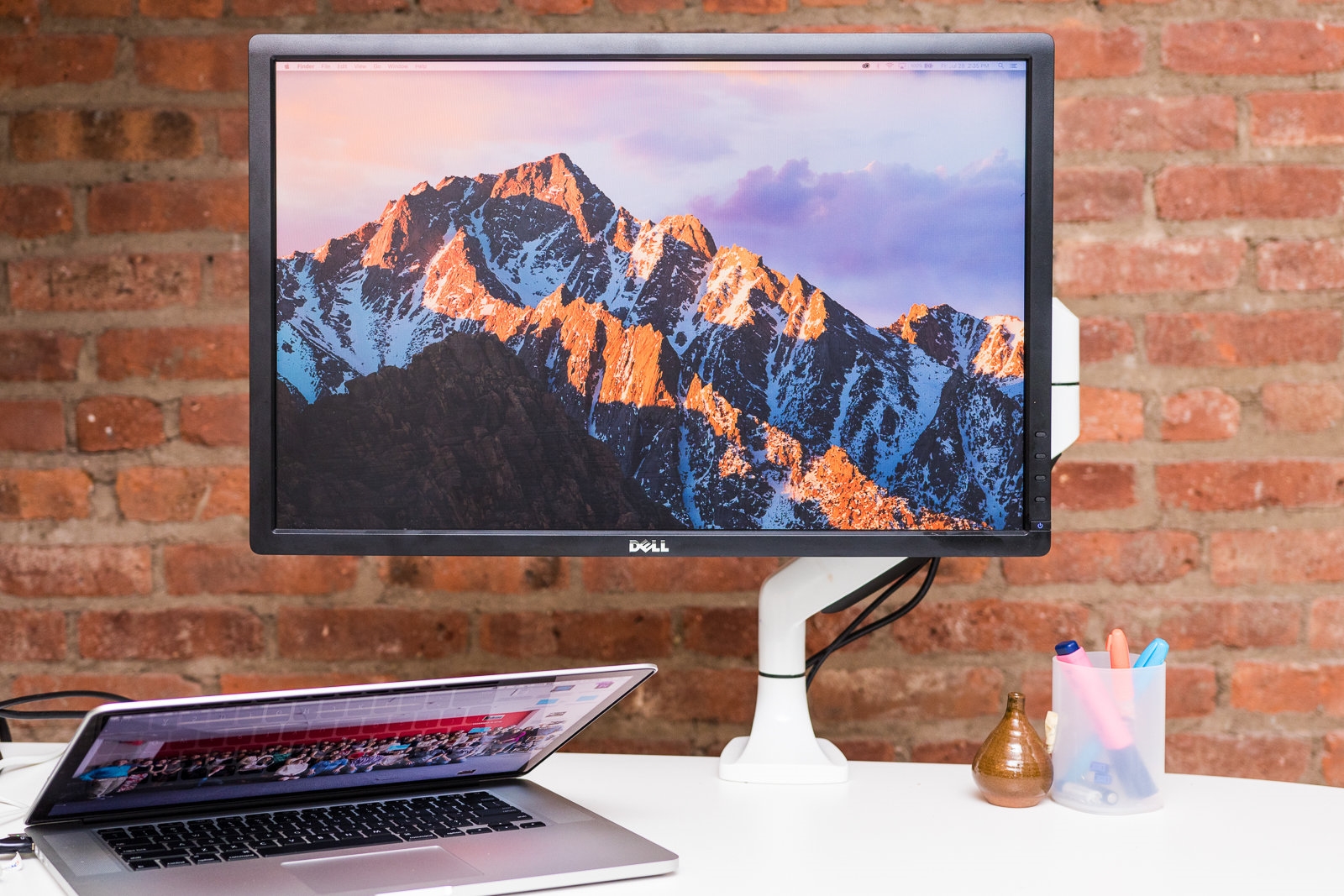
Flaws but not dealbreakers
The Fully Jarvis was slightly more difficult to set up than the Ergotron LX arm, even though Fully has improved the setup process since the last version we tested. The Jarvis is also difficult to set up alone, because you have to mount the arm to the desk before attaching the monitor; it’s possible to do solo, but an extra set of hands will make the process easier.
None of the models we tested—including the Fully Jarvis—impressed us when it came to cable management. Fully’s arm includes cheap-feeling plastic pieces that snap and slide on to the underside of the arm to manage cables. They’re a little more difficult to align than similar designs on other models, but since this is something you should rarely have to adjust, we don’t think it’s a dealbreaker.
Runner-up: Ergotron LX Desk Monitor Arm
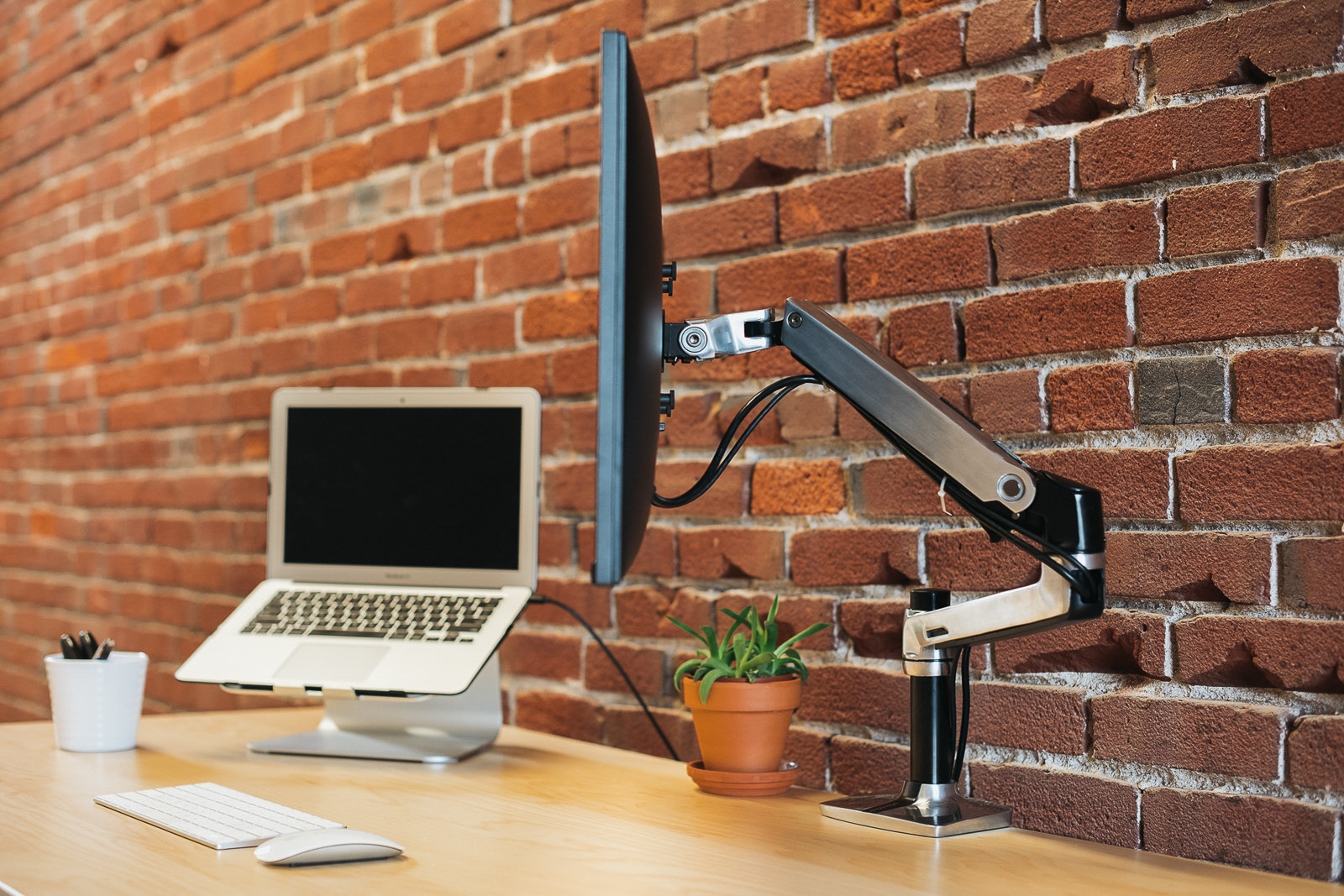
If our pick is sold out, we also like the Ergotron LX Desk Monitor Arm. The Ergotron LX offers nearly the exact same capabilities as the Jarvis, supporting monitors up to 34 inches, offering a 14-inch vertical range (allowing for a total height of 25 inches off the surface of your desk), and providing a 25-inch horizontal range. It costs more than the Jarvis, though, and aside from a 5-pound increase in its weight limit that we don’t think you’ll need, the only extra is an exceptional 10-year warranty.
There’s not much difference between the Ergotron LX and Fully Jarvis arms when it comes to how smooth they are or how far they adjust—the Ergotron should support the same range of monitors up to 34 inches, and the same range of positions too. Wirecutter lead editor Kimber Streams has been using the Ergotron LX since 2017 with a 27-inch monitor. “It works well for both sitting and standing heights, and has cleared off a ton of room on my desk compared to having a monitor on a stand on books,” Kimber said. “It’s also incredibly convenient to be able to move the monitor all the way back, off my desk, to have room to work on other projects.” We were able to set up the Ergotron LX without any hiccups or frustrations, too; as with most arms we tested, setup took about 20 minutes in total. Like the Jarvis, the LX has cable management that feels fairly cheap but not terribly so.
Flaws but not dealbreakers
The 10-year warranty is the only advantage the Ergotron LX has to justify the higher price compared with the Jarvis and Fully’s five-year warranty, and especially compared with the AmazonBasics Single-Monitor Mounting Arm, which is virtually identical to the Ergotron LX and notably cheaper but carries only a one-year warranty. A monitor arm is a significant investment, and one that will likely last longer than the monitor attached to it; we think the Ergotron’s warranty, amortized over a decade, is worth the extra cost. In the event you can’t get the Fully Jarvis, we think opting for the Ergotron LX is a better choice than going with an arm that has only one year of support, but if you disagree, the AmazonBasics arm is a fine alternative for less.
For tall people at a sit/stand desk: Ergotron LX Desk Monitor Arm, Tall Pole
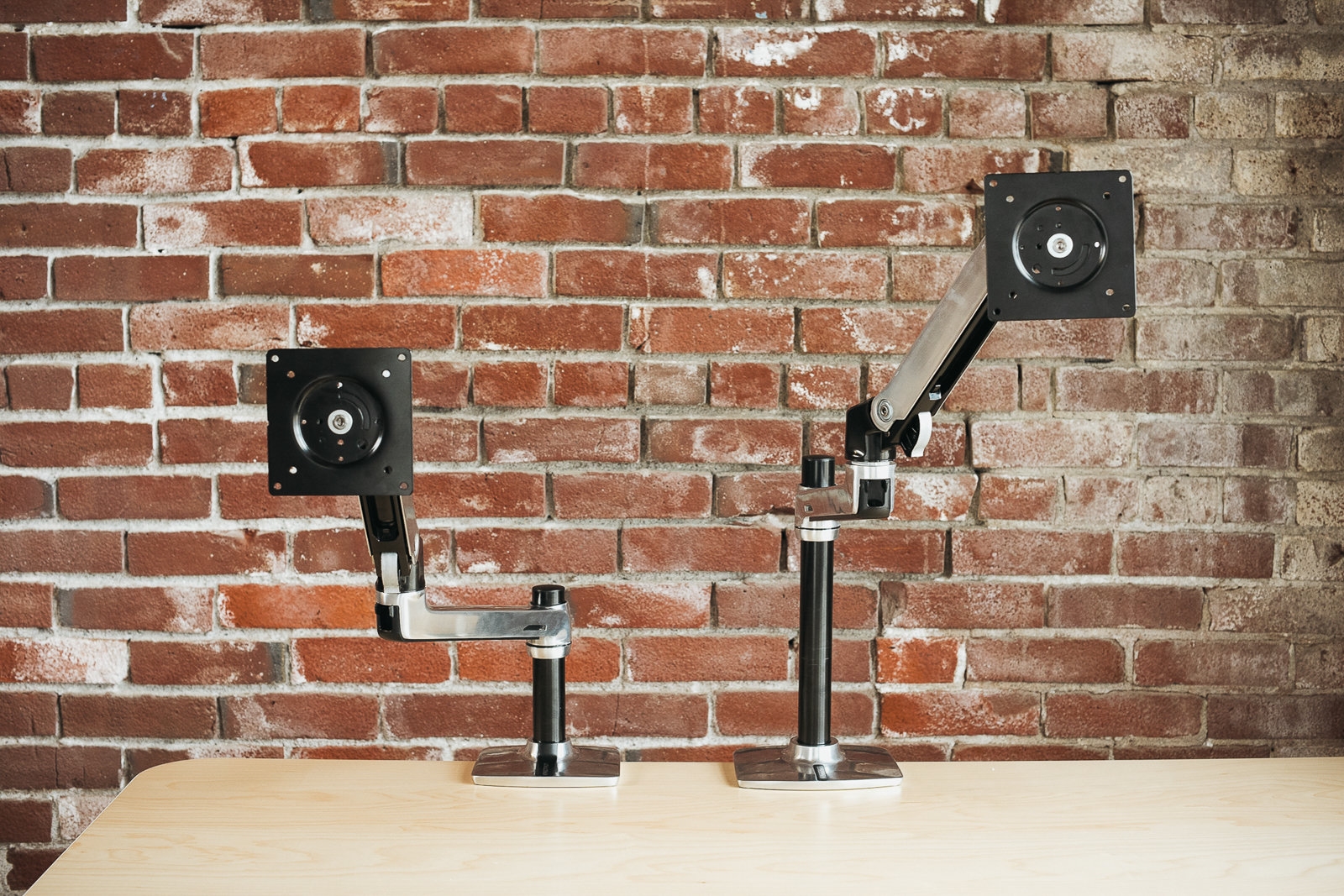
If you’re over 6 feet tall and need a monitor arm, we recommend the Ergotron LX Desk Monitor Arm, Tall Pole. The Tall Pole version is usually almost twice as expensive as the standard-height Fully Jarvis arm, but the Jarvis, like the AmazonBasics and other similar arms, isn’t quite tall enough to properly position a monitor for most people over 6 feet tall.
This arm offers the same support for up to 34-inch monitors as the regular Ergotron LX arm, a horizontal range of 25 inches, and a 13-inch vertical range on the arm itself. In addition, this model comes with a 13¼-inch pole that allows the arm to reach up to 34 inches vertically, a notable increase from the 19.8 inches the Fully Jarvis allows.
Two Wirecutter staffers—one 6-foot-2 and the other 6-foot-4—tested monitor arms on our favorite adjustable standing desk and found that regular-height arms weren’t tall enough for them. Wirecutter senior editor Nathan Edwards, who has used the Ergotron LX Tall Pole since 2014 with a 27-inch monitor, appreciates the extra height: “The extra pole height gives it enough of a range adjustment that it works for me in both sitting and standing scenarios, even though I’m 6-foot-4, and it’s sturdy enough that it doesn’t suffer from excessive wobble even in standing mode.”
The quality of the construction and the resulting motion are on a par with those of the Fully Jarvis—even though taller folks are penalized on price for the extra range, there’s no performance penalty here.
Like the standard-height Ergotron LX, the Tall Pole version offers a 10-year warranty, so you can expect the arm to last through your current setup and maybe even one more. Although we don’t think that warranty length is totally necessary compared with the five-year warranty Fully offers on its standard arm, we appreciate the extra coverage given the price increase for the tall-pole Ergotron.
For dual-monitor setups: Fully Jarvis Dual Monitor Arm
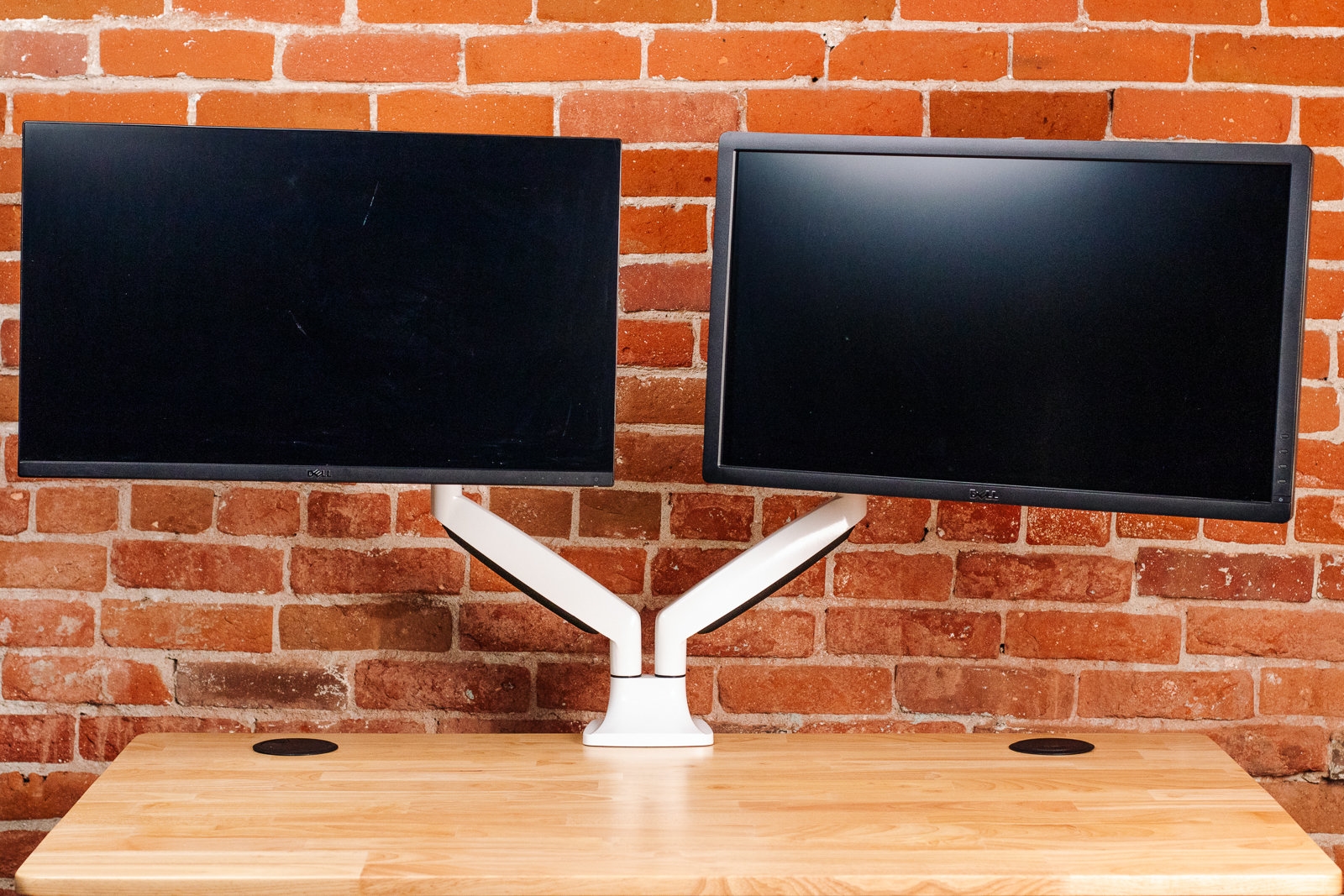
We recommend the Fully Jarvis Dual Monitor Arm for anyone who needs support for two monitors at their desk. Like the single-arm version, the Jarvis dual-arm model is sturdy and easy to adjust, and it has an impressive five-year warranty—four more years of coverage than you get with the AmazonBasics dual-arm model, for a lower price.
As on its single-arm counterpart, on the dual-arm Jarvis each arm supports monitors up to 32 inches that weigh up to 19.8 pounds, and this model had no problems supporting the pair of 27-inch monitors we tested with it. Both monitors have the same range as on the single-arm model, too: up to 19.8 inches vertical above the tabletop and 23.8 inches in horizontal range.
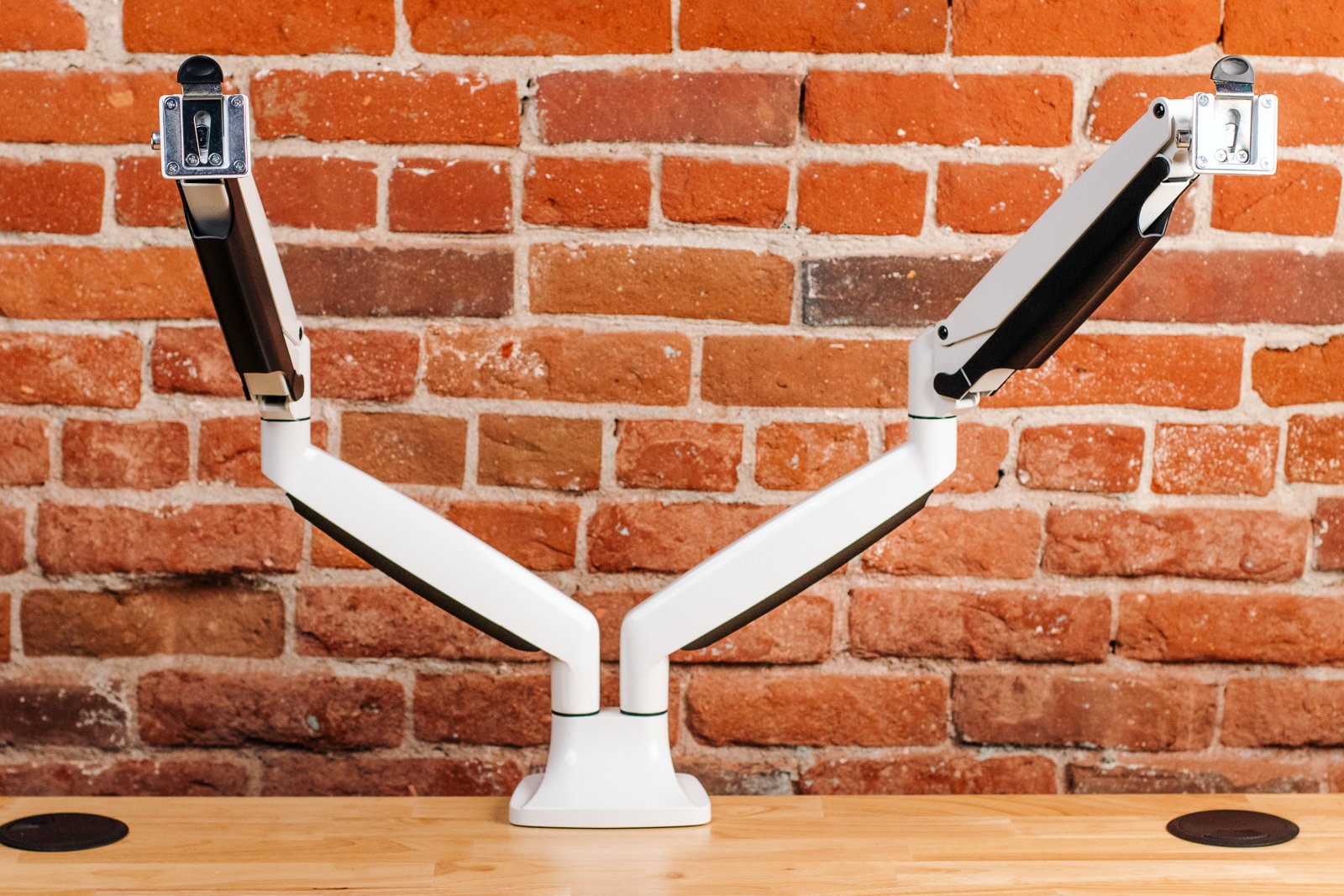
Although setup for this arm was a bit trickier than that of dual mounts from Ergotron and AmazonBasics—the VESA mount has a tab that you need to slide into the arm instead of just using screws—it’s a task that you have to do only once. As soon as you set it up, you can easily make adjustments while ensuring enough security to not worry about your monitor’s safety.
Even though Fully’s five-year warranty is only half as long as Ergotron’s coverage, the Ergotron dual-arm stand is typically just under twice the price of this Jarvis model. The other serious dual-arm competitor, from AmazonBasics, comes with a one-year warranty and is more expensive than the Jarvis. While we’d prefer a longer warranty, five years should be long enough to cover any issues that may pop up, and getting a 10-year warranty isn’t worth paying nearly twice as much.
The competition
We used to recommend the AmazonBasics Single-Monitor Mounting Arm, which is nearly identical to the Ergotron LX Desk Monitor Arm. But the Fully Jarvis arm generally costs the same, offers similar features, and has a five-year warranty instead of AmazonBasics’s one.
Ergotron and AmazonBasics likewise make dual-arm models that are nearly identical to each other and just as good as the Fully Jarvis dual-arm model. The Ergotron model has a 10-year warranty but is almost double the price, and the AmazonBasics version is more expensive than the Fully and has only a one-year warranty.
AmazonBasics offers a wall-mounted arm if you want to save even more space on your desk. Since not everyone can drill into a wall to mount their monitor, we chose to test arms that clamped onto a desk or used a grommet. Aside from the mounting mechanism, this wall model’s performance and range of motion are largely the same as those of the desk-mounted version we recommend. (The wall-mounted model can’t pan 360 degrees, though, because it’s attached to a wall.)
For a previous round of testing, we tested the Herman Miller Flo Monitor Arm and found it difficult to set up and adjust. The Flo has cable-management options superior to those of our pick, but we don’t trust this mount with a valuable monitor. In our tests, its desk clamp wasn’t sturdy even when fully tightened, and its mounting plate is made of plastic instead of metal. Plus, the Flo usually costs twice the price of our pick and doesn’t provide an option for very tall people.
We tested two monitor arms from Vivo, the Single Monitor Desk Mount and the Dual Monitor Desk Mount, which were both significantly cheaper than similar offerings from other companies. Although their prices were appealing, we found them harder to set up, and they didn’t cover as many angles as our picks.
The Ergotech Freedom Arm HD was harder to set up than our picks and required more parts. Adjusting the tilt of the monitor was more difficult, too.
In our tests, the Uplift Monitor Arm required a desk-imprinting clamp and proved to be harder to lock down at just the right height. Compared with the AmazonBasics and Ergotron arms, it was difficult to set up and adjust.
We considered testing the North Bayou F80, an Amazon best seller, but found that it had a more limited vertical range at just 9 inches. That can be an issue for anyone who’s over 5 feet 8 inches and intends to stand while working. Our picks are more adjustable and support a wider range of people and desk setups.
We also looked at the Halter Dual LCD Adjustable Monitor Stand, which looks identical to the Ergotron and AmazonBasics design but cost more than $200 at the time of our review.
This guide may have been updated by Wirecutter. To see the current recommendation, please go here.
When readers choose to buy Wirecutter’s independently chosen editorial picks, Wirecutter and Engadget may earn affiliate commissions.
(104)

